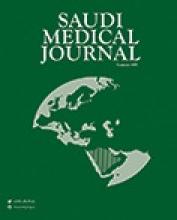Abstract
OBJECTIVE: To explore the role of radiological examination and certain biochemical values in diagnosis and assessing severity of nutritional rickets.
METHODS: Cases of symptomatic nutritional rickets (age range between 3-36 months) seen at King Abdul-Aziz University Hospital, Jeddah, Kingdom of Saudi Arabia, during the period 1997-1999 were studied. Clinical examination by the author of the study, determination of calcium (Ca), phosphate (PO4), alkaline phosphates (ALP), hand and wrist x-rays, were performed for all cases.
RESULTS: Sixty cases of nutritional rickets were diagnosed within 2 years (incidence of 0.5%), 38.3% of the patients presented with swollen wrist and 28.3% with bowleg. The bone profile at time of diagnosis: Ca = 2.33 +/- 0.23, PO4 = 1.47 +/- 0.40 and ALP = 925 +/- 418. Approximately 81.7% of the patients had normal Ca level, 18.3% had low serum PO4 level, 98.3% showed high value of ALP. X-ray studies indicated that, 58.3% of patients had active rickets, 35% had minimal changes, and 6.7% showed healed rickets. Among those having active rickets 20% had low PO4 level, 83% had normal Ca value, and 100% had high ALP. The mean value +/- SD of biochemical values in this group: Ca = 2.34 +/- 0.24, PO4 = 1.45 +/- 0.42, ALP = 1067 +/- 452. The later was significantly higher compared to other groups (P=0.004) but no significant differences were observed between mean values of other parameters.
CONCLUSION: Radiological examination and ALP remains essential to confirm clinical diagnosis of rickets and assessment of severity.
- Copyright: © Saudi Medical Journal
This is an open-access article distributed under the terms of the Creative Commons Attribution-Noncommercial-Share Alike 3.0 Unported, which permits unrestricted use, distribution, and reproduction in any medium, provided the original work is properly cited.






